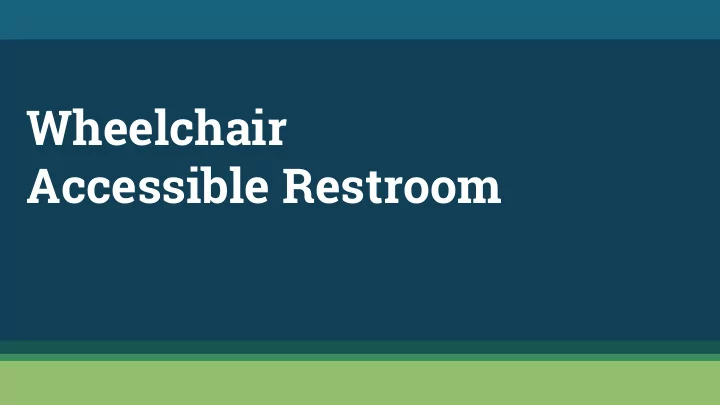

Wheelchair Accessible Restroom
W.A.R. 3 The Rachel Ackles | Project Manager Rachel Berry | Systems Engineer & Facilitator Team Nate Bracalente | Lead Mechanical & Fluids Engineer Jax Ohashi | Lead Systems Designer Don Phan | Purchasing & Test Engineer Daniel Vetere | Lead Communications / Design Engineer
Goals ▪ Finalize Requirements ▪ Verify problem statement ▪ Finalize Design Scope
Problem Statement: For people confined to wheelchairs, using public restroom facilities can be an extremely difficult and unpleasant experience, heightened if they have limited to no upper or lower mobility. As a result of this struggle, a trip to the restroom can take as long as an hour, leading users to avoid using public restrooms all together. Two of the main concerns are transferring from the wheelchair to the toilet and back, and the self cleanup process. The goal of this project is to design a device that will assist users in the transfer and cleanup process of using public handicapped restrooms to enhance their comfort and quality of life.
Stakeholders 1. Customer: Art North 2. People confined to wheelchairs 3. Caretakers 4. Donald Pophal 5. Doug Jaehn 6. Chris Hilderbrant 7. P19011 MSD Team 8. MSD Office
Scope 1. Little to no lower mobility 2. Some upper body strength 3. Low dexterity in hands 4. Fits in ADA compliant public restrooms
Constraints - Budget: $500 - Easily installed in handicapped restrooms - Resources for power available (i.e. certain level of water pressure, electrical) - Compliant with restrooms following ADA restrictions and requirements. - Adjustable for various models of toilets
Users in Mind Limited Lower Body Movement No Lower Body Movement ▪ Wheelchair users, can ▪ Wheelchair users, full stand/walk upper body use Motorized scooter users Wheelchair users, ▪ ▪ ▪ Walker users moderate upper body use ▪ Leg brace users ▪ Users with caretakers Crutches users ▪
Use Case Scenario I Wheelchair user, ADA restroom; moderate upper body strength no lower body use User removes User replaces User transfers User transfers User enters User cleans necessary necessary from chair to from toilet to the restroom themselves toilet chair garments garments -have to -cannot reach -have to lift/lower self under self lift/lower self onto toilet -cannot clean off of toilet -use toilet seat any accidents -use toilet seat -use grab bars -use grab bars
Use Case Scenario II Wheelchair user, W.A.R. 3 in restroom; moderate upper body strength no lower body use User removes User replaces User transfers User transfers User enters User cleans necessary necessary from chair to from toilet to the restroom themselves lifting seat lifting seat garments garments -adjust height of -lift seat as needed -adjust height of lifting seat -clean self seat -lift handle -lift handle -use handles to -use handles to transfer transfer to chair -replace handle -finish -lower seat
Current State, Future State and the Gap Future State: Current State: Adjustable Height ● Hydraulic Lifts ● ● Secure supports ● 8 in. height differential Increased ● Liftable Arm Rests ● Accessibility 420 in 2 footprint ● Minimal weight ● Max load 405 lbs ● required to ● 155 lb for descent descend
Customer Requirements
Engineering Requirements CR1.1 Facilitates easy transfer from wheelchair to toilet ER1.1 CR1.2 Make a stabilizing handle so Facilitates easy transfer from it takes less than 2 minutes toilet to wheelchair for transfer CR3.5 Compliant with ADA
Engineering Requirements CR1.3 Usable with manual or powered chairs ER1.2 CR2.1 Human testing using both Enables transfer without manual & powered using toilet seat wheelchairs CR3.5 Compliant with ADA
Engineering Requirements CR1.4 Usable with different height wheelchairs ER1.3 Functional seat that can raise/lower 10 inches CR3.5 Compliant with ADA
Engineering Requirements CR1.5 Usable by people with limited strength ER1.4 Individual with upper body strength can transfer on his/her own CR3.5 Compliant with ADA
Engineering Requirements CR1.7 Enables good personal hygiene CR1.8 ER1.5 Comfortable Make design easily accessible to clean and maintain (take less than 10 CR3.2 - CR3.4 minutes) Easy to install, maintain and clean CR3.5 Compliant with ADA
Engineering Requirements CR1.8 Comfortable ER1.6 Use ergonomic seating and arm rests CR3.5 Compliant with ADA
Engineering Requirements CR1.4 Usable with different height wheelchairs ER1.7 Adjustable seat, can be raised or lowered to any height in between the max CR3.5 and min heights. Compliant with ADA
Engineering Requirements CR2.1 Enables transfer without using toilet seat ER2.1 Make stabilizing handle for max load of 400 lbs (hold 400 lbs) CR3.5 Compliant with ADA
Engineering Requirements CR2.2 Free of sharp edges ER2.2 Round off any sharp edges CR3.5 Compliant with ADA
Engineering Requirements CR3.1 Low Cost ER3.1 Research cheaper materials for frame (keep under $500 budget) CR3.5 Compliant with ADA
Engineering Requirements CR3.2 Easy to install ER3.2 Create design as simple as possible for easy installation (one person per installation CR3.5 with simple tools) Compliant with ADA
Engineering Requirements CR3.3 Easy to maintain ER3.3 Ensure clearance between hydraulic lines and possible wheelchair positions CR3.5 Compliant with ADA
Engineering Requirements CR1.1 Facilitates easy transfer from wheelchair to toilet CR1.2 Facilitates easy transfer ER3.4 from toilet to wheelchair Additional grab bars should be 36" long and 33-36" CR1.5 & CR1.6 above the floor Usable by people with limited strength/mobility CR3.5 Compliant with ADA
Risk Management - consideration is key
Next Steps.. In the next phase we plan to evaluate design concepts and options.
Questions?
SlidesCarnival icons are editable shapes . This means that you can: Resize them without losing quality. ● Change line color, width and style. ● Isn’t that nice? :) Examples:
Recommend
More recommend